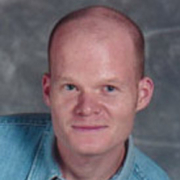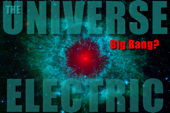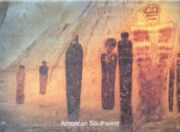Big Bang Cosmology: Going Down a Black Hole?
01/20/2008
It must be difficult for young people today to comprehend the wonder with which
humankind once regarded space exploration. Most kids have spent their lives
soaking up CGI special effects in Hi-Def and surround sound, so a routine Space
Shuttle launch in the real world can't seem too impressive. Even worse, Sci-Fi
movies with cosmic themes have been almost universally poor since at least the
mid-1980's. "Incidental" filmmaking nuances like character development, dialog
and psychological truth are eschewed in favor of hyper-kinetic special effects
and ultra-violence. Whereas filmmakers Kubrick, Lucas, and Spielberg once made
us ponder what it means to be human, Michael Bay makes us wonder WHY human
beings exist.
Cosmic Sci-Fi has become boring, because cosmology is boring -- at best. Other
apt descriptives include stultifying, mind-numbing, threadbare, and insipid. The
picture of the cosmos as presented in popular scientific media is one bereft of
vitality and inspiration. But when one considers the direction of space science
for the past several decades, how could it be otherwise?
Ever since Einstein opened the door to a confusing language of time and space,
mass, matter and energy, mathematical abstractions have come to dominate
standard cosmology. The picture is terribly "dense," both literally and
figuratively. Today, we are told that 96% of the Universe is made of theoretical
(and invisible) "dark stuff" that has never been seen or measured, and by
definition can never be tested in a laboratory. We are also told that at the
center of every galaxy is an invisible "supermassive black hole" that devours
everything in its wake. Big Bang cosmology so heavily relies on these unseen,
untestable ghosts "proven" only by abstract equations that -- as many critics
have noted -- little distinction remains between space science and science
fiction.
Not unlike fiction authors, scientists understand that they cannot survive
without public fascination, because no interest in their work means no
"respectability" and no funding. But PR efforts in the space sciences must be
inherently challenging. An obvious problem is that it all seems to be occurring
in remote never-lands of meager concern to earthlings. So, to provoke the
interest of the jaded layperson, astronomers and cosmologists continually churn
out hyped-up, mostly-improbable threats that the public is likely to find
titillating and/or frightening. (Then of course they make assuring statements,
telling us not to be frightened because of this or that technological fix that
they have thought up -- requiring, of course, big funding to achieve.) Today,
these are primarily speculations about asteroids impacting earth, the
never-ending (and profoundly disingenuous) "search for alien life," and the
ubiquitous, all-devouring "black hole." All of these provide plenty of fodder
for computer-enhanced, dramatized television "docudramas" portraying these
fantastic events as if, in the manner of the "War of the Worlds" (fake) news
drama, they were actually occurring.
Of course, the science-popularizing press just loves black holes. In fact, black holes have been "seen"
in recent years performing exotic and previously undreamed of feats with such
numbing regularity that some critics have wondered aloud, "Is there anything a
black hole CAN'T do?" Recent "news" items include speculations that hundreds of
"intermediate mass," "rogue" black holes may be "roaming the Milky Way galaxy"; a black hole shooting "a
death ray" at a neighboring galaxy;
black holes spinning "at speeds approaching the speed of light"
;
and a research group claiming to have "succeeded for the first time in revealing
the state inside a black hole by
computer simulations using superstring theory."
With official science almost always discussing black holes as if they were an
established fact rather than a theory, what is the layperson to make of these
outlandish objects?
First and foremost, it's imperative that we understand what astronomers actually
mean when they claim to "see" a black hole. Long before scientists began
speculating about "dark matter" and "dark energy," astrophysicists observed that
galactic cores exhibit vastly more concentrated energetic activity than could be
achieved by gravity alone, unless something hugely massive (yet incredibly
small) were present. So they effectively "divided by zero." They employed the
near zero force of gravity to explain a nearly "infinite" compression of matter
-- the only thing they could "see" under their theoretical assumptions. It's no
longer physics; it is, as Wallace Thornhill calls it, "a school-kid math
howler." They called these speculative, monstrous concentrations of matter
"black holes," imagining that they "consume everything around them." See
"A
Brief History of Black Holes" for "a brief but accurate account of events,
verifiable by reference to the original papers, by which the scandalous
manipulation of both scientific and public opinion is revealed."
As technology improved, the original black hole theoretical model was quickly
contradicted by facts. Suddenly, the theorists imagined that an "accretion disk"
and magnetic field (which they claim can somehow exist with no contribution from
electric currents) could produce a narrowly-confined jet across millions of
light years.
So let's understand this, very clearly -- scientists have never "seen" black
holes. They've seen (unanticipated) energetic effects that they imagine can only
be caused by the destruction of matter, i.e. a theoretical black hole "sucking"
and "consuming" everything around it due to the supposed (but impossible)
infinite gravity. Popular discussion of black holes can only be described as
disingenuous in the extreme. The contradictory, unexpected observations are
routinely presented as evidence confirming black holes' existence! The
improbable jets have never had a reasonable place within gravitational dogma, a
fact rarely if ever acknowledged in scientific media.
But the abstract and purely mathematical reasoning that led to black holes is
wholly unnecessary, according to proponents of the Plasma Universe and Electric
Universe. Far from the spotlight of media attention, plasma cosmologists did
anticipate many of the "surprising" discoveries of the space age, with no
requirement of invisible, untestable ghosts and equations involving imaginary
infinities. As early as 1937, the father of plasma cosmology, Nobel Laureate
Hannes Alfven, proposed that our galaxy contains a magnetic field and that the
charged particles move in spiral orbits owing to forces exerted by the field.
Through experimentation over many decades, Alfvén and others further
demonstrated the established complex properties and characteristics of plasmas.
And now, plasma physicists can trace the evolution of observed galactic forms
from basic electromagnetic principles. This last point has been demonstrated
most persuasively by plasma scientist Anthony Peratt, a student of AlfvΓ©n.
Peratt's supercomputer simulations and experiments have shown that the
interaction between cosmic Birkeland filaments -- with no imaginary dark matter,
no "voracious" black holes -- naturally produces an accumulation of matter at
the currents' intersection, leading to spiral galactic structure and rotational
motions that accurately match observations. As further confirmation at a level
of detail, the simulations show "flat rotation curves" and many other
characteristics summarized
here.

In an electric universe, galaxies are born from high-energy, electrical events
whose signature can now be seen in space. Take a moment and consider the image
above of the Radio Galaxy 3C31 (also called NGC 383). This galaxy is a MINUSCULE
object, little more than a dust mote, when seen against the immense display of
highly energetic charged particles. Electrons in twin polar jets, accelerated to
near the speed of light, are evidence of the most intense electrical discharge
activity known to science. Our instruments detect this activity through its
synchrotron radiation and through the twin lobes of high-energy radio signals.
So how is this huge region of electrical activity to be interpreted? In standard
models, an electrically-neutral galaxy is asked to generate electrical activity
across volumes of space THOUSANDS of times greater than the volume of the
galaxy. But simple electrodynamics says this is impossible! How does a
galactic-size, neutral object produce a vast domain of electrical activity
around it? A plasma cosmologist looking at this image will see electric currents
incomparably larger than the galaxy, being focused down by a plasma "pinch," at
energy levels capable of lighting and organizing stars into the observed
galactic structure. Indeed,
Winston H. Bostick produced such behavior in the
laboratory years before the counterparts were observed in space.
Plasma scientists have demonstrated a superior ability both to predict and to
explain space observations using only principles well-documented in the
laboratory over many decades. And in fact, their predictive record has only
improved with the emergence of technologies capable of mapping the full cosmic
electromagnetic spectrum. As physicist Eric J Lerner observed in the IEEE
Transactions on Plasma Science: "...the predictions of plasma cosmology have
been strengthened by new observations, including evidence for the stellar origin
of the light elements, the plasma origin of large-scale structures, and the
origin of the cosmic microwave background in a 'radio fog' of dense plasma
filaments."
Over 99% of the Universe consists of plasma, which can conduct electricity as
easily as copper metal. And while it tends to be electrically neutral overall,
electrically charged regions may occur on areas such as double layers and
particle beams. It is well known by all physicists that magnetic fields and
electric currents affect the charged particles in plasmas far more than gravity
does. And according to the electrical theorists, in space plasma these same
forces organize galactic structure and provide the external energy that powers
stars, including our own Sun.
Plasma science is attracting interest because it explains physical reality in a
manner that is consistent, comprehensible, logical, and most importantly,
testable. Many also sense an inherent meaningfulness in the interconnectedness
of all in an electric plasma universe -- as Wal Thornhill and Dave Talbott have
written, "No isolated islands exist in space."
In stark contrast, according to critics in increasing numbers, the esoteric
mathematics of standard cosmology is inconsistent, incomprehensible, illogical,
and worst, almost entirely untestable in the real world. Can one gain a sense of
meaning from a field seemingly overrun by mathematical fantasies? Although they
may be internally consistent, they have no reality or meaning outside their own
constructed framework of thoughts.
To see just how little regard standard cosmologists now seem to have for
empirical reality, one need look no further than the recent NY Times "science"
headline, "
Big Brain Theory: Have Cosmologists Lost Theirs?" According to the
cosmologists cited in the article -- which features a staggering overabundance
of standard and quasi-standard quantum speculations about "spacetime," "parallel
universes," and multiple "big bangs" -- the bottom line is that "you yourself
reading this article are more likely to be some momentary fluctuation in a field
of matter and energy out in space than a person with a real past born through
billions of years of evolution in an orderly star-spangled cosmos. Your memories
and the world you think you see around you are illusions."
If you think the above is an absurd, grotesque, and frankly misanthropic fantasy
unworthy of your attention, the Times author does little to increase your
confidence with the following declaration: "Nobody in the field believes that
this is the way things really work, however." If this is so, why are they
indulging in these speculations at our expense?
The most ironic observation in the article is that "Nature tends to do what is
easiest, from the standpoint of energy and probability." If standard
cosmologists actually believed this, would they not have abandoned their
chalkboards in favor of the laboratory years ago? The easiest way to produce
radio jets, X-ray jets and synchrotron radiation emissions is not through
collisions of gas particles, or theoretical "black holes" swallowing matter.
(See Postscript below). Logically, these are the effects of large-scale plasma
discharge phenomena, well-documented in the laboratory. And the laws of physics
observed in the lab do not cease in the vast reaches of space!
It is still possible for humankind to recapture a genuine sense of wonder and
enthusiasm for space exploration. But nothing less than an intellectual -- and
institutional -- revolution is required. Wallace Thornhill observes in his
piece, 2008 -- Year of the Electric Universe: "Humanity was never more in need
of a new science of Life in the Universe. Our hopeless, detached cosmology
permeates our lives. We thrash about in ignorance, nonsense and illogicality,
seeking real meaning to our existence....A real cosmology must reunite the
sciences, humanities and the arts. It cannot be limited to astronomy. It must
give real meaning to Life. It is becoming clear to more and more scholars and
the questioning public from around the world that the Electric Universe offers
such a broad vista of future science. It is time to get started in 2008. We have
no time to lose."
POSTSCRIPT
The following excerpt from Thornhill and Talbott's "The Electric Universe"
further elucidates the "problem" that galactic synchrotron radiation poses for
standard models of the cosmos:
A good test of contrasting approaches is provided by galactic synchrotron
radiation, a non-thermal form of electromagnetic radiation from particles
accelerated in an electromagnetic field rather than by collisions with other
particles (such as will occur in an electrically neutral but high-temperature
flare or explosion). Synchrotron radiation is emitted by charged particles
accelerated to near light speed along spiraling paths following the ambient
magnetic field. High-energy plasma discharges always produce synchrotron
radiation.
Since galactic emissions of synchrotron radiation are a fact, their effect has
been to shine the harshest light on the failure of purely gravitational models.
Considering the particle velocities required for synchrotron radiation over vast
distances, even a mythic black hole could not do the job. So theorists have
taken another speculative leap, calling upon a 'super-massive black hole'
equivalent to the mass of billions of suns, accelerating charged particles along
magnetic field lines by the force of gravity-a flight of imagination that gives
new meaning to the phrase 'doing things the hard way.'
The TPOD "
Two Black Holes" provides a perfect example of the discussion above:
...the galaxy cluster Abel 400, whose X-ray emissions are almost entirely
synchrotron radiation, (indicate) extreme electrical stresses.
But electricity is not something astronomers are eager to hear about. They are
not fond of electrical currents in space, because the possibility that
electricity generates large scale structure is alien to their theoretical
models. To generate the observed levels of energy seen in Abell 400 using
nothing but the puny force of gravity more matter would have to be squeezed into
a galaxy than a galaxy could hold. But the theorists are mathematicians, and
they work with equations, not with real objects. This permits them to ignore
empirical limits on density and let the amount of matter per unit volume
increase without limit: The 'neutron stars' and 'black holes' conjured through
this mathematical license can be placed wherever needed to explain away the
stunning and potentially embarrassing energy excesses.
Permalink to this article.
Public comment may be made on this article on the
Thunderbolts Forum/Thunderblogs (free membership required).
For a highly-acclaimed 60-minute video introduction to the Electric Universe, see
Thunderbolts of the Gods on Google Video.
|

Michael Goodspeed is a freelance journalist who lives in Beaverton, Oregon
My Archives
Chronological Archives
Archives by Author
Archives by Subject
Thunderblogs home
|





